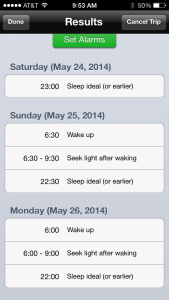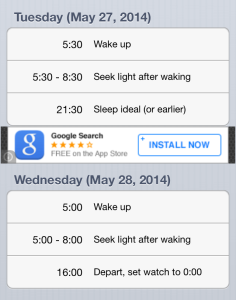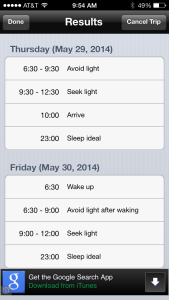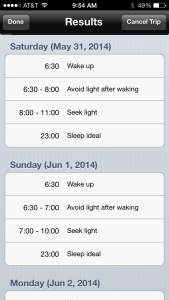An App to Prevent a Common Travel Woe – Jetlag Rooster
While like many seasoned road warriors I like to believe that I’m immune to jetlag (with boasts like “my body clock is broken”, I’m definitely guilty of this), the reality is that even a tiny amount of internal disruption can wreck havoc on vacation plans if the internal clock cannot be reset. For me, jetlag not only means not being able to sleep at appropriate times (and wanting to doze off at inappropriate times!) but also general sluggishness and an upset digestive system for several days after switching time zones.
On a recent trip to board a cruise in Istanbul, I was desperate to both get quality sleep before and after my vacation started. So I decided to turn to mobile apps to see what might be available.
I located many paid apps offering customized jetlag management plans but I was nervous about trying one for a fee. But one free app stood out – Jetlag Rooster.
The Application
Jetlag Rooster is based off scientific principles that resetting your body’s natural sleep patterns via enforced wake times and specified periods of light/darkness can help reset your natural rhythms to cushions some of the shock of moving across several time zones.
The app asked me for several pieces of information – when I was departing, where I was flying from and to, what my departure and arrival times were, and what my normal wake up and sleep times are. It uses that information to help get your sleep patterns adjusted to your new time zone in the specified time period. It also offered several options – to acclimate before departing, to begin acclimating when my flight took off, or to begin acclimating after arrival.
I reviewed all three options (which revealed one of the annoying parts of this app – there was no way to save information so I had to rekey it each time to look at all three options). I decided I liked the acclimate before departing option best in terms of what I thought would work with my schedule. So I saved that option and viewed my results.

My results yielded a plan that was workable for me. I was to start cutting back my normal bedtime by 30 minutes each evening leading up to my departure in four days. I was also to wake up earlier and expose myself to as much light as I could for a period of time after waking.
I encountered my first difficulty on Monday. I woke up early even though it was Memorial Day and sat on my front porch for three hours with my coffee. I had to take a 10 pm flight that evening however that would have me arriving at my hotel well after midnight. I compensated by taking a long nap on Monday afternoon. This left me groggy however which caused me to question the effectiveness of the plan!

On Tuesday, I was able to get up at the specified hour (although the late arrival on Monday night made me extremely tired that morning) and when I arrived back at home that night, I went straight to bed. The early wake up helped me fall asleep at what would have normally been an early hour for me!
I boarded my delayed Lufthansa flight (DFW-FRA) around 4 pm on Wednesday and followed my normal onboard routine (enjoy dinner, watch a movie, then sleep). Thanks to that morning’s early wake up and fatigue from running several pre-departure errands, I was tired. I was able to sleep until about an hour before landing in Frankfurt and didn’t raise my window shades until close to landing so I was fairly close in on this schedule.

I had a twelve-hour layover and normally my routine would be to go to the First Class Terminal and immediately try to reserve a nap room. Instead, I took a shower and settled in to get some work done. I waited until after lunch (close to 2 pm) before I took a three hour nap to offset that my flight to Istanbul was not leaving until after 10 pm and I would not likely get to my hotel until after 2 am.
For me, jetlag usually starts to hit late in the day on my first day after arrival and I was starting to doubt whether the Jetlag Rooster would work but I felt refreshed after my nap and was able to enjoy dinner and some light reading without feeling at all sleepy.
As predicted, it was close to 3 am before I arrived at the Grand Hyatt Istanbul thanks to long lines at immigration and delays with checked baggage. I was four hours past my suggested bed time
On Friday, I woke up around 7 am and managed to avoid light until after 9. At that point, I forced myself to go down to the lounge for breakfast and stayed awake until noon when I took a nap. I spent my afternoon and evening out around town and didn’t go to bed until well after midnight, but slept better that night than I normally do on the first day after arrival, especially given a few days of decreased sleep times.

Saturday was the true test of how well the Jetlag Rooster had worked. I woke up around 7 am (so later than suggested) and avoided light until after 8 am. And I made it the entire day without a nap and stayed up relatively late that night. My jetlag was nonexistent.
Summary
The Jetlag Rooster suggestions were great if I had complete control of my schedule for the days before and after my time-zone hops. Alas, business realities and travel schedules don’t always allow for this degree of judgment. Nonetheless, I was pleased with how much better I felt with some adjustments to my schedule.
One major flaw of the app is the inability to alter a plan once it has started – any changes to the data require beginning a brand-new plan. It would be nice to have functionality that allows one to save trips that are frequently taken so that a personal plan can be archived. But the interface is easy to use and offers good basic suggestions that are worth downloading this free app.
This application is available for Android 2.2 and above or iPhone iOS 5.1 and above. The Jetlag Rooster website also offers other helpful advice and tools for managing jetlag.
6 Comments
Comments are closed.